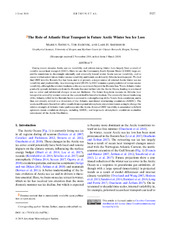| dc.contributor.author | Årthun, Marius | |
| dc.contributor.author | Eldevik, Tor | |
| dc.contributor.author | Smedsrud, Lars H. | |
| dc.date.accessioned | 2020-04-28T07:56:18Z | |
| dc.date.available | 2020-04-28T07:56:18Z | |
| dc.date.issued | 2019-05-14 | |
| dc.Published | Årthun M, Eldevik T, Smedsrud LH. The Role of Atlantic Heat Transport in Future Arctic Winter Sea Ice Loss . Journal of Climate. 2019;32(11):3327-3341 | eng |
| dc.identifier.issn | 1520-0442 | en_US |
| dc.identifier.issn | 0894-8755 | en_US |
| dc.identifier.uri | https://hdl.handle.net/1956/22030 | |
| dc.description.abstract | During recent decades Arctic sea ice variability and retreat during winter have largely been a result of variable ocean heat transport (OHT). Here we use the Community Earth System Model (CESM) large ensemble simulation to disentangle internally and externally forced winter Arctic sea ice variability, and to assess to what extent future winter sea ice variability and trends are driven by Atlantic heat transport. We find that OHT into the Barents Sea has been, and is at present, a major source of internal Arctic winter sea ice variability and predictability. In a warming world (RCP8.5), OHT remains a good predictor of winter sea ice variability, although the relation weakens as the sea ice retreats beyond the Barents Sea. Warm Atlantic water gradually spreads downstream from the Barents Sea and farther into the Arctic Ocean, leading to a reduced sea ice cover and substantial changes in sea ice thickness. The future long-term increase in Atlantic heat transport is carried by warmer water as the current itself is found to weaken. The externally forced weakening of the Atlantic inflow to the Barents Sea is in contrast to a strengthening of the Nordic Seas circulation, and is thus not directly related to a slowdown of the Atlantic meridional overturning circulation (AMOC). The weakened Barents Sea inflow rather results from regional atmospheric circulation trends acting to change the relative strength of Atlantic water pathways into the Arctic. Internal OHT variability is associated with both upstream ocean circulation changes, including AMOC, and large-scale atmospheric circulation anomalies reminiscent of the Arctic Oscillation. | en_US |
| dc.language.iso | eng | eng |
| dc.publisher | American Meteorological Society | en_US |
| dc.rights | Attribution CC BY | eng |
| dc.rights.uri | http://creativecommons.org/licenses/by/4.0/ | eng |
| dc.subject | Arctic | eng |
| dc.subject | Sea ice | eng |
| dc.subject | Ocean circulation | eng |
| dc.subject | Climate change | eng |
| dc.subject | Climate variability | eng |
| dc.subject | Coupled models | eng |
| dc.title | The Role of Atlantic Heat Transport in Future Arctic Winter Sea Ice Loss | en_US |
| dc.type | Peer reviewed | |
| dc.type | Journal article | |
| dc.date.updated | 2020-02-13T09:04:05Z | |
| dc.description.version | publishedVersion | en_US |
| dc.rights.holder | Copyright 2019 American Meteorological Society | en_US |
| dc.identifier.doi | https://doi.org/10.1175/jcli-d-18-0750.1 | |
| dc.identifier.cristin | 1719925 | |
| dc.source.journal | Journal of Climate | |
| dc.relation.project | Norges forskningsråd: 263223 | |
| dc.relation.project | Norges forskningsråd: 276730 | |

